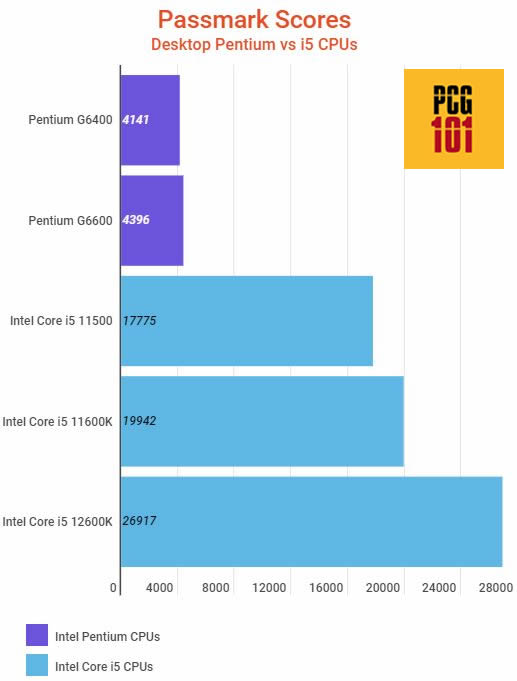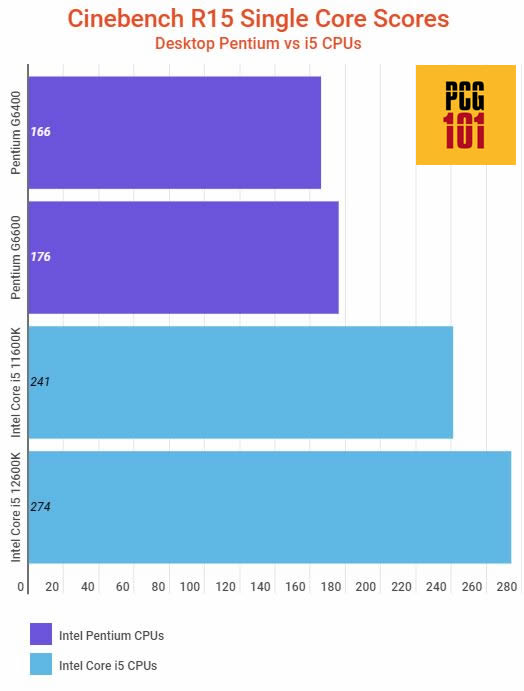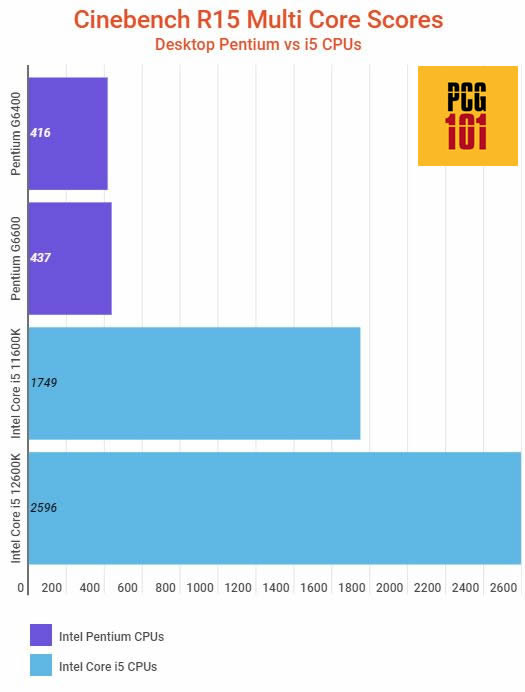Intel Pentium and Intel Core i5 completely differ in performance and price categories. They are so far apart regarding differences that a simple comparison is ridiculous. Yet, more often than not, those who are entirely new to PC hardware often ask about the differences between Intel Pentium vs. i5.
Intel Pentiums are entry-level CPUs, whereas an Intel Core i5 is a mainstream CPU. The current generation of Intel Pentium CPUs offers 2 cores, whereas the current generation of Intel Core i5 offers 6-10 cores.
Hence as far as the performance goes, the Core i5 CPUs are light years ahead. However, Intel Core i5 CPUs are far more expensive and often reserved for enthusiasts, gamers, and professionals.
In the following text, I will compare Intel Pentium vs. i5 in several parameters, including:
TABLE OF CONTENTS
Differences Between Intel Pentium vs. i5
To establish how the Intel Pentium compares to the i5, I will look at the following parameters:
- Clock Speed and Core Count comparison
- Performance comparison
- Price and Value comparison
- TDP comparison
- Use Cases comparison
1. Clock Speed and Core Count Comparison Between Intel Pentium vs. i5
Pentium CPUs have a meager core count. Even the best ones at the moment are dual-core CPUs.
Intel Core i5s, on the other hand, offers 6 cores for laptops and desktop variants.
The 12th gen CPUs have introduced a completely different core count configuration featuring Performance and Efficiency cores.
Also Read: How Many Cores Does an i5 Have?
The following table explains more:
| CPU | Specs |
Type |
Remarks |
| Intel Pentium Gold 6405U | 2.4 GHz 2 Cores 4 Threads |
Laptop/ Mobile |
Flagship and Popular laptop-based Intel Pentium CPU |
| Intel Pentium G6400 |
4.0 GHz 2 Cores 4 Threads |
Desktop | Popular; desktop-based Pentium CPU. |
| Intel Pentium G6600 |
4.2 GHz 2 Cores 4 Threads |
Desktop | Flagship; desktop-based Pentium CPU. |
| Intel Core i5-11500H |
4.6 GHz Max 6 Cores 12 Threads |
Laptop/ Mobile |
Flagship and Popular laptop-based Intel Core i5 CPU |
| Intel Core i5-12600K | 4.9 GHz Max 6 P-Cores 4 E-Cores 12 P-Threads 4 E-Threads |
Desktop | Flagship and Popular; desktop-based Core i5 CPU. |
You can see from the table above that there is a huge difference in specs when comparing the latest Pentium and i5 CPUs for desktops and laptops.
For Desktops, the 12th Generation flagship i5 CPU, the Core i5-12600K, features 10 Cores (6 performance cores and 4 efficient cores). In addition to that, it features 16 threads in total and has a very high clock speed of 4.9 GHz.
On the other hand, the desktop flagship Pentium Gold G6600 only features 2 cores and 4 threads with a max clock speed of 4.2 GHz.
The Laptop Intel Pentium and Core i5 CPUs are also drastically different in performance. While the flagship laptop Pentium 6405U only has 2 cores and 4 threads, the current 11th gen flagship laptop Core i5 11500H offers 6 cores and 12 threads.
2. Intel Pentium vs. i5 Performance Comparison
As mentioned earlier, the Intel Core i5 CPUs are light years ahead in performance compared to Intel Pentium CPUs.
To gauge the performance difference, I will use the scores from PassMark and Cinbench R15 benchmarks to compare desktop Pentium and Core i5 CPUs.
Also Read: How is Processor Speed Measured?
Performance Comparison of Intel Core i5 and Pentium Desktop CPUs

- Scores are taken from CPUBenchmark.net


- Cinebench R15 scores taken from CPU-Monkey.com
No matter your benchmark, you will almost always find the Core i5 CPU significantly more potent than the best Pentium CPUs.
According to PassMark, the Intel Core i5 12600K is more than 6 TIMES as powerful as the Intel Pentium G6600 CPU (26,917 vs. 4396)!
Hence when it comes to performance, there is no comparison between the two Intel series.
3. Price and Value Comparison
To determine the value of a CPU, you have to look at its performance/dollar value.
To determine this, we can take the PassMark score of each CPU and divide it by the MSRP in USD of the CPU.
For simplicity’s sake, I will take the flagship desktop CPUs from both series.
| CPU | PassMark Score |
MSRP |
Performance/Dollar* |
| Intel Pentium G6400 |
4141 | $64 | 64.7 |
| Intel Pentium G6600 |
4396 | $93 | 47.26 |
| Intel Core i5-11500 |
17775 | $202 | 87.99 |
| Intel Core i5-12600K | 26917 | $299 | 90 |
- To calculate performance/dollar value, I am dividing the PassMark score by its MSRP.
- Higher the Performance/Dollar score, the better the value.
- MSRP was taken from Intel.com
You can see here that the Intel Core i5 performs better and has a much better performance/dollar value than the Intel Pentium i5.
So much so that the Intel Core i5 12600K offers almost twice the value for money compared to Intel Pentium G6600.
4. TDP Comparison
TDP, or Thermal Design Power, loosely defines the electricity the CPU uses and the amount of heat it generates.
Generally, the higher the performance of a CPU, the higher its TDP would be.
A higher TDP means you have to provide adequate cooling to the CPU, which adds to the cost of the overall build.
| CPU | TDP (W) |
| Intel Pentium G6400 |
58 |
| Intel Pentium G6600 |
58 |
| Intel Core i5-11500 |
65 |
| Intel Core i5-12600K |
150 |
As expected, higher-performing CPUs often have a very high TDP. This is particularly true for flagship Core i5 CPU for desktops such as the Intel Core i5 12600K.
Even the best desktop-based Intel Pentium CPUs have a far lower TDP than Intel Core i5s.
Laptop CPUs have the lowest TDP, so much so that some laptop CPUs can even have a TDP of 8W. Laptop CPUs have lower TDP to conserve battery life.
As such, a Laptop Pentium and a Laptop Core i5 have weaker performance than their desktop counterparts.
Read in Detail: Laptop vs. Desktop CPUs
5. Use Cases of Intel Pentium and Intel Core i5
Both Intel Pentium and Core i5 serve very different market segments.
In the Intel performance hierarchy, Intel Pentium is on the bottom rung. The Intel CPU hierarchy looks something like this:
- Intel Core i9
- Intel Core i7
- Intel Core i5
- Intel Core i3
- Intel Pentium
- Intel Celeron
Where the Intel Core i9 is the most powerful commercial Intel CPU.
Intel Pentium Serves the Budget Market Segment
Intel Pentium is an entry-level series that caters to users on a budget or those requiring basic productivity.
They are great for day-to-day computing and also sufficient for office use.
They are not built for gaming or professional editing and designing software.
Also Read: Is Intel Pentium Good for Gaming?
Intel Core i5 Serves the Mainstream Market Segment
Intel Core i5 is some of the most capable CPUs and is among the most popular among gamers, budding editors, and designers.
Regarding their Single Core performance, they are as capable as the i7 and i9 CPUs. The core count is the only significant difference between an i5 and an i7/i9.
Regarding multi-core performance, an i5 is weaker than an i7/i9; however, UNLESS you are a professional editor who renders tons of videos or a regular streamer who streams games while playing them on ultra-high settings, an i5 should more than suffice.
Also Read: Does Motherboard Matter for Gaming?
Final Words
It is funny to compare Intel Pentium vs. the i5 since an i5 is a beast in front of the Pentium.
However, things can get confusing for uninitiated and new PC builders, particularly since Intel has many different lines of CPUs. Understanding each and their sub-models can give even adepts a headache.
Also Read: Difference Between Intel Celeron vs. i3
FREQUENTLY ASKED QUESTIONS
1. Are Pentium processors more power-efficient than i5 processors?
Generally, Pentium processors consume less power and generate less heat compared to i5 processors. This is because Pentium processors are designed to operate at a lower clock speed and have fewer cores, resulting in lower power consumption.
2. Can a Pentium processor handle demanding applications like video editing or 3D modeling?
While a Pentium processor can technically handle video editing and 3D modeling applications, it may not be the most optimal choice.
These applications tend to be very demanding and require a processor with a higher clock speed, more cores, and a larger cache. In such cases, an i5 processor or higher would be a better option.
3. Which generation of Pentium and i5 processors should I choose for my needs?
The generation of Pentium or i5 processor you should choose depends on your specific needs and budget.
Newer generations tend to have better performance and more features, but they can also be more expensive.
It is important to consider your intended use case and the performance requirements of your applications before making a decision.
4. How do Pentium and i5 processors compare in terms of multitasking performance?
Generally, i5 processors perform better than Pentium processors when it comes to multitasking.
This is because i5 processors have more cores and threads, allowing them to handle more tasks simultaneously.
Pentium processors are designed to handle basic computing tasks, so they may struggle with heavy multitasking.
However, the exact performance difference between the two will depend on the specific models being compared.
